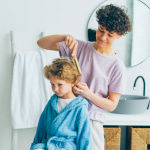National Bug Busting Day in the UK Date in the current year: June 15, 2026
 National Bug Busting Day is observed in the United Kingdom three times a year: on January 31, June 15, and October 31. It is a school campaign that aims to reduce the incidence of lice and prevent their spread across classrooms.
National Bug Busting Day is observed in the United Kingdom three times a year: on January 31, June 15, and October 31. It is a school campaign that aims to reduce the incidence of lice and prevent their spread across classrooms.Head lice are wingless parasitic insects that live on the human scalp and feed exclusively on human blood. Unable to fly or even jump, they are transmitted from host to host through head-to-head contact or shared items (brushes, combs, hats, towels, bedding, etc.). There is a common misconception that head lice infestations are caused by poor hygiene, but they are in fact quite common, especially in children between 4 and 13 years of age and their families.
The National Bug Busting Day campaign was launched in the UK to reduce the stigma associated with head lice and encourage parents and educators to regularly check kids for lice. It is spearheaded by Community Hygiene Concern (CHC), a health and education charity that works to protect people and pets from common parasites, in partnership with the UK Department of Health and Social Care.
The main goals of the campaign are to promote the Bug Busting method of eradicating lice and encourage schools across the country to detect and eradicate head lice together on a predetermined day. National Bug Busting Days are supposed to reduce stigma (because all students are checked for lice at the same time and no one is singled out) and prevent lice from circulating from student to student.
Bug Busting is a method of detecting and eradicating head lice via wet combing. The CHC puts together Bug Buster Kits that educators can order for their students. Each kit contains a wide-tooth comb for untangling, four specially designed bug-busting combs, a protective cape, step-by-step instructions, an informational booklet, and fun stickers.
The process of eradicating lice using a Bug Buster kit consists of several simple steps:
- Wash the child’s hair with their regular shampoo and rinse.
- Apply lots of conditioner and leave it in the hair.
- Use a wide-tooth comb to untangle and straighten the hair.
- Comb through the hair with a mini or maxi Bug Buster comb from root to tip, section by section. Mini Bug Busters work best on young children, whereas the use of maxi Bug Busters is preferred on older children and adults.
- Wipe both sides of the Bug Buster on a paper towel or rinse it under running water to remove any lice.
- Comb each section several times until the Bug Buster is louse-free. If the hair begins to dry, spray it with warm water to keep it wet.
- Rinse the hair and leave it dripping wet. Untangle and straighten the hair once more with the wide-tooth comb.
- Comb through each section once more using a mini Bug Buster to find any remaining lice.
- Switch to the purple Nit Buster to get rid of lice eggs (nits).
The Bug Busting method works so well because thoroughly wet hair soaked in conditioner keeps the lice still, and the combs are specifically designed to prevent even baby lice from escaping. To get rid of lice completely, you should repeat the procedure three more times with 3-day intervals between the sessions.
- Category
- Other Observances
- Country
- United Kingdom
- Tags
- National Bug Busting Day in the UK, observances in the UK, health-related observances, head lice, Bug Busting